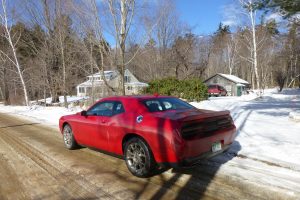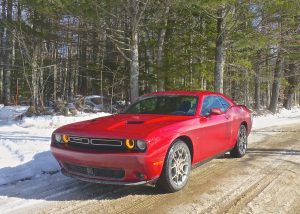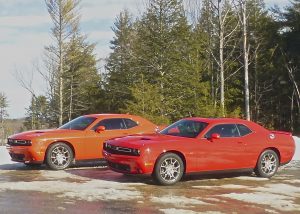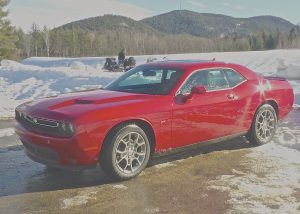Challenger GT adds AWD for winter muscle
By John Gilbert
PORTLAND, Maine — Driving a powerful muscle car on a curving icy roadway can become a sudden thrill when it breaks traction and starts skidding as if it intends to broadslide into the snowbank on the right shoulder.
“Oops!” just doesn’t quite cover it.
But the instincts gained while driving up and down the hills od Duluth, Minnesota, paid rich dividends. I didn’t yank the steering wheel into the direction of the skid, and I didn’t abruptly hit the brakes. Instead, I eased off the gas slightly while steering in an attitude that let the vehicle’s traction-control straighten us out and continue on our intended path as I eased back into the middle of our lane.
“Good job,” said my co-driver, who had good reason to be less poised than I was as we sailed through the woods just outside Portland, Maine. We were cheating, though, because the red Challenger we were in was a pre-production GT model with all-wheel drive.
It’s not as though we don’t get enough winter weather in Northern Minnesota, but there was no way to pass up this opportunity. Dodge invited a group of auto journalists to visit the rock-bound coast of Maine at the end of January for the first chance to drive the new Challenger GT, which, for 2017, can be bought with all-wheel drive. As such, I felt obligated to push it toward its limits.
The Challenger is a vehicle that is always fun to drive, joining the Ford Mustang and Chevrolet Camaro among the three “ponycar” throwbacks — I call them “future retro” — because they recreate the Trans-Am road-racing heyday of the late 1960s and early 1970s in North America. Dodge calls them “Muscle Coupes,” which is OK, too.
The three were ferocious rivals in road-racing, and among the joys of my sports and auto writing career was to be able to cover that Trans-Am series at places such as Donnybrooke Speedway (now BIR, for Brainerd International Raceway), Elkhart Lake, Bridgehampton and all points where road-racing circuits existed. They were a diversion from the hot-rod sedans of the late 1960s and the spider-like open-wheeled formula cars, with 2 doors and a specific silhouette of long-hood, short rear deck.
The Mustang continued on while the Camaro and Challenger were discontinued along with the Pontiac Trans-Am, Plymouth Barracuda, American Motors Javelin and a few others. But about the time Ford decided to redo the Mustang in a style that recaptured the attitude and demeanor of the 1970 model, Camaro came back out and did the same thing, and so did Challenger.
Dodge’s great-looking Challenger was created by dropping the coupe body on the platform for the larger Charger 4-door sedan, and the shortcut produced a very competitive vehicle. In some ways, it has an edge.
Some say the Challenger looks most like the 1970 car, but in any event it has a larger trunk and a more spacious interior, which can actually house a couple of adults in something approaching comfort. But in all cases, the Challenger, Mustang and Camaro are summertime cars, with front-engine, rear-drive that makes for enormous fun in the summer, spring and fall, but virtually need to be parked in the winter if you live in snowy weather. No traction control system can conquer the glare ice of winter with a rear-driver.
The Dodge Charger added a model a few years ago with an all-wheel-drive system underneath. While the arsenal of Hemi V8s make both the Charger and Challenger fly, the very strong 3.6-liter Pentastar V6 is more than capable in the Charger and Challenger, and works well enough in the AWD version of the Charger that many police departments deploy it to chase — and catch — the bad guys in bad weather.
We should have anticipated this move, then. Dodge has refined that all-wheel-drive system for the smaller Challenger coupe. “We were able to take the all-wheel-drive system from the Charger and use it in the Challenger,” said chief engineer Allison Rahm. “It’s not exactly the same, because we had to refine it in a few ways. We took the Charger Pursuit sedan, used by some police departments, and adapted the suspension, stabilizer bars, springs and steering calibration, and gave it its own vehicle dynamic control that uses the same front-axle disconnect.

Instead of being skittish, and skiddish, the Challenger GT has newfound stability, even on icy rural roads of Maine..
“We have developed the perspective on a test area we use in Northern Michigan, where they have huge snow-pack fields. We learned we can push the car and stay in control, so it’s fun, cool, and you can drive it very confidently. It goes back to rear-wheel drive when you don’t need it, but in snowy conditions, or when it senses wheelspin, its sensors can send up to 100 percent of the torque to the front.”
How the car is being driven also activates AWD, and the unit only adds 200 pounds to the overall weight of the Challenger, which sits low and doesn’t betray the fact that all four wheels can pull the car.
Ben Lyon showed us an interesting map of the U.S. with a horizontal line across the middle, from northern California to the East Coast. Market research indicates all-wheel-drive models of the Charger and such SUVs as the Durango are up 12 percent year-over-year in sales from last year. On the Charger, AWD makes up 17 percent of purchases altogether, and in the 17 states north of that horizontal line across the nation, the take rate is over 50 percent all-wheel drive on vehicle purchases.
“We also surveyed buyers who looked at the Challenger but didn’t buy,” said Lyon, the Challenger brand manager. “One-third said all-wheel drive was important, and when they stopped considering the Challenger, half of them then bought something with all-wheel drive.”
We had our choice of colors and I took red, instead of orange. Both were stunning. Powering the Challenger is that Pentastar V6, a 3.6-liter unit with 305 horsepower at 6,350 RPMs, and 268 foot-pounds of torque at 4,800 RPMs. More than 90 percent of the peak torque is provided from 1,800 to 6,400 revs which gives you pretty constant power anywhere in the tach’s range.
The only thing that rivals that power is the audio system, which barks through a 506-watt amplifier. A surprisingly large trunk and fold-down rear seat allow you to haul long things, even skis. Specific GT leather bucket seats and trim on the dash and console set the car apart as well.
Naturally, all the goodies boost the price. Our test car started at $33,395 and as-tested it was $40,555.
Stability control and all the assumed connectivity features of Apple CarPlay and Android Auto can be brought to life. Also, the performance information from the Hellcat Trac Pak with readouts on the 8.4-inch center screen let you monitor 0-60 times, G-forces and a launch-control device.
For driving performance, the power is harnessed by the 8-speed automatic with paddle shifters, and if you switch into Sport mode, or drive aggressively, you are immediately in all-wheel drive. Otherwise, your driving style will summon AWD instantly and seamlessly by assessing road conditions.
We found driving the Challenger GT smooth and precise, with the possible exception of my little unscheduled side-skid that threatened the shoulder. So we were ready for the test track, even as the temperature climbed to a less-than-challenging 45 degrees. We would have prefered the harshness of the “Nor’easter” that hit the area one day earlier.
I had the chance to be first out on the well-groomed test track at a road-racing course Dodge had contracted, with a circular stability track, a straight line acceleration stretch, and a small autocross-like circuit that could challenge us for our driving response and the car’s capability.
The stylish 19-inch wheels were shod with some high-performance all-season Michelin tires, and they proved pretty good — but not exceptional to a winter-driving veteran. Michelin might be the best at building tires for long wear and high speed, but to do that, the tread compound is firm enough that it becomes hard — and slick — in severe cold. Such as winter.
The production Michelins worked well to test the car around the circular skid course, where you could jockey the car back and forth and even provoke a bit of skidding, just for fun. After several laps around that, in 6-inch deep snow, we moved over to the auto-cross like course.
The groomer had done a great job smoothing out the trail, and my instructor informed me that I could be confident staying on the power if we got off into the deeper snow. I got off a little, putting the left-side tires into the fringe area, and when I stayed on the power, it went a bit farther off, until it got hung up.
I know enough to stay on the power in moderate snow, and I did that, right until it hung itself up, What fooled us was that the groomer had groomed a bit wider than the outer groove, so when I thought I was still on the track, the left side tires already were off the surface. No problem. Four guys tried to push me out, but we had to summon the groomer, which hooked up to the rear and pulled us out of the snow.
That may have helped set the stage for the rest of . I suggested to Ms. Rahm, the chief engineer, that the Michelins were probably excellent for 90 percent of the all-weather driving Dodge might anticipate for the car’s use, but I would suggest a set of Nokian all-season or snow tires.
I’m guessing that won’t happen, because no automaker builds a car with tires aimed specifically at snow-country. And that’s OK. All-wheel drive already gives the Challenger GT AWD a large jump on Mustangs and Camaros — and virtually all other muscle cars — on snow and ice. With the right winter tires, it could could make hardy drivers park their SUVs.






 John Gilbert is a lifetime Minnesotan and career journalist, specializing in cars and sports during and since spending 30 years at the Minneapolis Tribune, now the Star Tribune. More recently, he has continued translating the high-tech world of autos and sharing his passionate insights as a freelance writer/photographer/broadcaster. A member of the prestigious North American Car and Truck of the Year jury since 1993. John can be heard Monday-Friday from 9-11am on 610 KDAL(www.kdal610.com) on the "John Gilbert Show," and writes a column in the Duluth Reader.
John Gilbert is a lifetime Minnesotan and career journalist, specializing in cars and sports during and since spending 30 years at the Minneapolis Tribune, now the Star Tribune. More recently, he has continued translating the high-tech world of autos and sharing his passionate insights as a freelance writer/photographer/broadcaster. A member of the prestigious North American Car and Truck of the Year jury since 1993. John can be heard Monday-Friday from 9-11am on 610 KDAL(www.kdal610.com) on the "John Gilbert Show," and writes a column in the Duluth Reader.